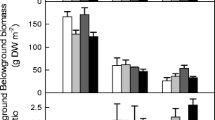Abstract
Former laboratory results indicate that shoot elongation at low light intensities of Chara aspera is absent already at 10 psu which is within the physiologically optimal salinity range for brackish water populations. To investigate if similar restrictions occur in the field, density and morphology of C. aspera were compared between three freshwater and three brackish water sites along its depth range.
The lower depth limit of C. aspera varied considerably among sites (30–600 cm) related to turbidity. Light availability at the lower depth limit corresponded to about 15% of surface irradiance in freshwater and brackish water with lower salinity (3.4 psu). Total length increased and fresh weight:length ratio decreased with depth at these sites indicating shoot elongation related to lower light availability. Due to shoot elongation, light availability was far higher at the upper parts of the shoot than at the bottom in the turbid sites. Light availability at the lower depth limit was higher (about 40%) at two sites with higher salinity (7–8 psu), where no shoot elongation was observed at the lower depth limit. Instead, the plants were stunted and often covered with filamentous algae or shaded by other rooted submerged macrophytes indicating competitive disadvantages of C. aspera at higher salinities.
As growth in high densities (mat formation) exposes the plants to severe self-shading, it is suggested that shoot elongation is a prerequisite to mat formation. Dense vegetation of C. aspera was found only in freshwater and brackish water with lower salinity. Single, richly branched plants occurred in clearwater sites with higher salinity. C. aspera was not found in “double stress” environments with both high turbidity and high salinity: We asume that the species is a poor competitor under these conditions.
Our results indicate that morphological differences between freshwater and brackish water populations of C. aspera are at least partly explained by salinity rather than genetic differences.




Similar content being viewed by others
References
Blindow, I., 1992a. Decline of charophytes during eutrophication: comparison with angiosperms. Freshwater Biology 28: 9–14.
Blindow, I., 1992b. Long- and short-term dynamics of submerged macrophytes in two shallow eutrophic lakes. Freshwater Biology 28: 15–27.
Blindow, I., 2000. Distribution of charophytes along the Swedish coast in relation to salinity and eutrophication. International Reviews in Hydrobiology 85: 707–717.
Blindow, I., J. Dietrich, N. Möllmann & H. Schubert, 2003. Growth, photosynthesis and fertility of Chara aspera under different light and salinity conditions. Aquatic Botany 76: 213–234.
Blindow, I., A. Hargeby & G. Andersson, 2002. Seasonal changes of mechanisms maintaining clear water in a shallow lake with abundant Chara vegetation. Aquatic Botany 72: 315–334.
Chambers, P. A. & J. Kalff, 1985. Depth distribution and biomass of submersed aquatic macrophytes communities in relation to Secchi depth. Canadian Journal of Fisheries and Aquatic Sciences 42: 701–709.
Chambers, P. A. & J. Kalff, 1987. Light and nutrients in the control of aquatic plant community structure. I. In situ experiments. Journal of Ecology 75: 611–619.
Croy, C. D., 1982. Chara aspera (Charophyta). Breeding pattern in the northern hemisphere. Phycologia 21: 243–246.
Domin, A., H. Schubert, J. C. Krause & U. Schiewer, 2004. Modelling of pristine depth limits for macrophyte growth in the southern Baltic Sea. Hydrobiologia 514: 29–39.
Hargeby, A., G. Andersson, I. Blindow & S. Johansson, 1994. Trophic web structure in a shallow eutrophic lake during a dominance shift from phytoplankton to submerged macrophytes. Hydrobiologia 279/280: 83–90.
Hasslow, O. J., 1931. Sveriges characéer. Botaniska Notiser 1931: 63–136.
Kamermans, P., M. A. Hemminga & D. J. de Jong, 1999. Significance of salinity and silicon levels for growth of a formerly estuarine eelgrass (Zostera marina) population (Lake Grevelingen, the Netherlands). Marine Biology 133: 527–539.
Martin, G. & K. Torn, 2004. Classification and description of phytobenthic communities in the waters of the West-Estonian Archipelago Sea. Hydrobiologia 514: 151–162.
Moore, K. A., D. J. Wilcox & R. J. Orth, 2000. Analysis of the abundance of submersed aquatic vegetation communities in the Chesapeake Bay. Estuaries 23: 115–127.
Munsterhjelm, R., 2005. Natural succession and human-induced changes in the soft-bottom macrovegetation of shallow brackish bays on the southern coast of Finland. Walter and Andrée de Nottbeck Foundation. Scientific Reports No. 26. Helsinki.
Olsen, S., 1944. Danish Charophyta. Det Kongelige Danske Videnskabernes Selskab. Biologiske Skrifter, Bind III, Nr. 1. Copenhagen.
van den Berg, M., H. Coops, M. -L. Meijer, M. Scheffer & J. Simons, 1998. Clear water associated with a dense Chara vegetation in the shallow and turbid Lake Veluwemeer, The Netherlands. In Jeppesen, E., Ma. Søndergaard, Mo. Søndergaard & K. Christoffersen (eds), The Structuring Role of Submerged Macrophytes in Lakes. Springer, 339–352.
Wallström, K. & J. Persson, 1997. Grunda havsvikar i Uppsala Län. Västra Öresundsgrepen. Stencil Nr. 12 (Report). Upplandsstiftelsen, Uppsala, 47 pp (in Swedish).
Winter, U. & G. O. Kirst, 1990. Salinity response of a freshwater charophyte, Chara vulgaris. Plant Cell and Environment 13: 123–134.
Winter, U. & G. O. Kirst, 1991. Partial turgor pressure regulation in Chara canescens and its implications for a generalized hypothesis of salinity response in charophytes. Botanica Acta 104: 37–46.
Winter, U. & G.O. Kirst, 1992. Turgor pressure regulation in Chara aspera (Charophyta): the role of sucrose accumulation in fertile and sterile plants. Phycologia 31: 240–245.
Acknowledgements
We thank Nils Möllmann for assistance in the field and laboratory and Peter Hansson for diving assistance in Lake Storacksen. The study was financed by the German Research Foundation (DF-G, project no. BL 559/3–1).
Author information
Authors and Affiliations
Corresponding author
Rights and permissions
About this article
Cite this article
Blindow, I., Schütte, M. Elongation and mat formation of Chara aspera under different light and salinity conditions . Hydrobiologia 584, 69–76 (2007). https://doi.org/10.1007/s10750-007-0578-9
Issue Date:
DOI: https://doi.org/10.1007/s10750-007-0578-9




